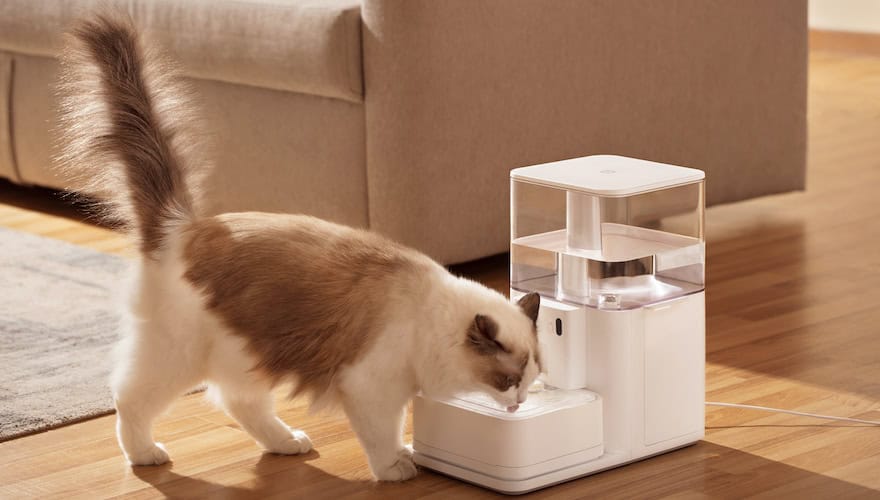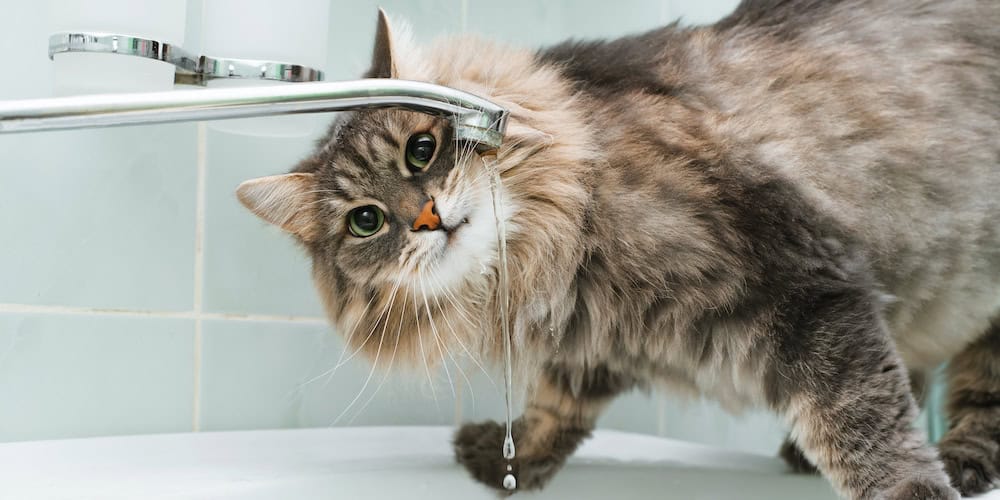“My cat drinks a lot!” or “It is drinking more than usual” are fairly common reasons for veterinary consultations.
Outdoor living, multiple water sources… A cat’s lifestyle means it can be very difficult to tell when they’re drinking more than usual.
When an animal drinks more than usual, it is called polydipsia. This term is defined as an increase in water consumption above the normal daily amount.
Several causes can lead to polydipsia in cats, for example a disease such as diabetes or hyperthyroidism.
Whatever the cause of polydipsia, identifying it allows for appropriate treatment. I therefore encourage you to contact your veterinarian if this applies to your cat.
In any case, I also recommend that you always leave several bowls of fresh water available for your cat.
📚 Read also | A veterinarian selected the best cat kibble based on 3 criteria
How much water does a cat need?
Cats’ water needs
A cat drinks, on average, 50 mL of water per kg per day. That means a cat that weighs 5 kg normally drinks about 250 mL of water per day.
I would, however, like to draw your attention to the link between water intake and diet. Indeed, if your cat is fed a wet diet (canned food or homemade rations), the amount of water it drinks is lower because its food already contains water.
On the other hand, if your cat eats only dry kibble, which is low in water. Your cat’s daily water consumption therefore approximates the value presented earlier.
How to find out how much water my cat drinks
Unlike dogs, knowing how much water your cat drinks each day is no easy task.
If your cat goes outside or lives outdoors, it has multiple water sources, which makes the task complicated.
However, if your cat lives strictly indoors, there are water fountains and water dispensers that allow you to calculate how much water your cat drinks per day.
Also remember that some cats drink more than normal, notably kittens or pregnant and nursing female cats, due to their increased water requirements.
What to do when my cat drinks a lot?
Detecting other symptoms
If you think your cat is drinking much more than usual, I recommend closely observing for any other signs: has its appetite changed? Does it have diarrhea?
Since we have seen that polydipsia and polyuria are often linked, also try to look at the appearance of your cat’s urine. Is it clear or, on the contrary, dark? Do you notice blood in its urine?
In general, any behavioral sign or change should be reported to your veterinarian, in addition to polydipsia, so as to have as much information as possible to reach the correct diagnosis.
Make an appointment with your veterinarian
You have certainly understood: a consultation with your veterinarian is necessary!
Additional tests should be performed to investigate the cause of polydipsia, notably urine tests (dipstick and measurement of urine specific gravity) or blood tests.
Also, some medications have diuretic effects, glucocorticoids for example. So be sure to inform your veterinarian of any current treatments to determine whether it might be an effect of the medication.

Why is my cat drinking so much?
Polydipsia or polyuria
Often, polydipsia is accompanied by polyuria, meaning your cat urinates more.
Be careful not to confuse polyuria and urinary incontinence.
Polyuria and polydipsia are therefore frequently linked, this is called polyuro-polydipsia (PUPD). And it’s easy to understand: either your cat drinks a lot and consequently urinates more; or it urinates a lot and therefore drinks more to compensate for these water losses.
I therefore recommend that you observe your cat’s urination if you notice it is drinking more than usual.
From diabetes to kidney failure
Numerous diseases can cause PUPD in cats. For example, diabetes, or more precisely the different types of diabetes.
On the one hand, diabetes mellitus is a disease in which the blood glucose (sugar) level is higher than normal. Glucose is often present in the urine, which is called glucosuria. The kidneys therefore excrete more water to dilute this glucose present in the urine.
On the other hand, diabetes insipidus can also be a cause of PUPD. It is a disease in which water filtration in the kidney is compromised. Water is not properly reabsorbed in the body and a larger volume of urine is produced.
This list is by no means exhaustive and there are many other causes: kidney failure, Addison’s disease, leptospirosis, etc.
A behavioral cause
Some dogs can be affected by potomania. It is a behavioral disorder in which dogs drink large amounts of water compulsively.
However, potomania has not been reported in cats, which do not appear to be affected. This study nonetheless raises the hypothesis of potomania in cats.
Sources and scientific studies
Report « Polyuria-polydipsia in the dog and cat », Le Point Vétérinaire no. 391 of 12/01/2018, pp. 27-44.
M. SCHMID Sarah, « A Stepwise Diagnostic Approach to Polyuria and Polydipsia », Today’s Veterinary Practice, Internal Medicine, 10/17/2023



